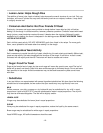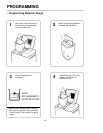
- 11 -
becomes gluten.When kneaded, gluten becomes elastic and gives the breads better stru c t u r e. I n
c o n t rast, all-purpose flour, milled from a combination of soft and hard wheat, becomes elastic too
easily for use in a bread machine and quickly loses its ability to stretch we l l . As a result, bread made
from all-purpose flour will be small and dense. S eve ral we l l - k n own mills now market bread flour. It is
labeled bread flour on the package and is ava i l a ble at gr o c e ry stores.
Wheat is the only grain that contains the type of protein that becomes elastic when kneaded. O t h e r
f l o u r s, such as rye, barl ey, oats, soy, rice and bu ckwheat, add flavor and fiber to breads but do not
add structure to the dough. T h e r e fo r e, wheat flour is essential as a base when making bread.
Vital Wheat Gluten is produced by processing white flour one more step. White flour contains both
protein and starch, and mills now can remove most of the starch leaving only the protein (gluten).
When gluten is added to recipes containing whole grain flours, it improves the volume and shape of
the loaf significantly. M a ny gr o c e ry stores stock gluten in the flour section. Health food and nu t ri t i o n
centers also carry this item.
Flour is best kept in an airtight container. If you need to store flour for a long period of time, keep it
in the freeze r, not the refri g e ra t o r. R e f ri g e rators tend to dry out the flour. Whole grain wheat flours,
which have a higher oil content, will become rancid much more quickly than white flour and should
a l ways be kept in the freeze r. A l l ow all flours to return to room temperature before placing in the
m a c h i n e.
When adding ve g e t a bl e s , fruits and nuts to recipes, do not exceed the amount listed. T h e s e
p r o d u c t s, if used in ex c e s s i ve amounts, may inhibit the rising of the bread.
Because different climates and seasons result in a wide va riety of humidity leve l s, the liquid amounts
called for in a recipe may need to be adjusted. C h e ck the dough ball half way through the second
kneading cycle. It should be round, smooth-textured, soft and slightly tacky to the touch. If it does not
fo rm a ball and is more like batter, add 1 tablespoon of flour at a time until the appropriate consistency
is reached. If the mixture is too dry to fo rm a ball or fo rms more than one ball, add 1 teaspoon of
water and allow it to absorb. Add more water if necessary.
Ⅲ Fat: Dough Enhancer And Conditioner
The recipes in this book use ve g e t a ble oil. Solid shortening, butter or margarine may be substituted
in equal proport i o n s. Divide into small pieces before placing in machine.There will not be any notice-
a ble flavor diffe r e n c e.The crust may be a little crispier with bu t t e r. M a r g a rine tends to make the cru s t
a little tougher. Light or whipped margarine does not wo r k we l l .
Ⅲ Liquids: Activate The Yeast And Bind The Dough
“ L i q u i d ” means all the wet ingredients used in the recipe. When yeast is used in a bread machine,
the liquid temperature must be 80°F/27°C. With this tempera t u r e, the yeast activates gradually to
accommodate the program of the machine. When higher temperatures are used, not only does the
yeast activate too quick l y, but also the entire dough ball becomes too wa rm .
When the machine is set on the delay timer, reduce the amount of liquid in most recipes by
1-2 teaspoons depending on the recipe and size of loaf.
Eggs are also considered part of the total liquid amount. Eggs need to be at room tempera t u r e. I f
t a ken directly from the refri g e ra t o r, place in a bowl of wa rm water to take off the chill before using.
DO NOT USE EGGS OR ANY PERISHABLE FOODS WITH THE DELAYED SETTING.


















